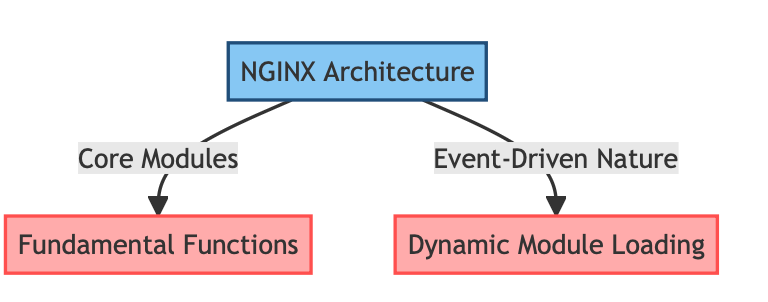By: Himanshu Tiwari, International Center for AI and Cyber Security Research and Innovations (CCRI), Asia University, Taiwan, nomails1337@gmail.com
ABSTRACT:
The strong and popular web server NGINX is known for its efficiency and scalability in managing web traffic. Modular architecture lets users add custom modules to NGINX, making it versatile. NGINX modules’ architecture, types, practical applications, development methods, integration techniques, problems, and future trends are examined in this research study. The paper illuminates these features to help readers understand how NGINX modules optimise web server performance and suit user needs.
1. INTRODUCTION:
Web servers rely on NGINX for speed, efficiency, and customization. Modularity makes it adaptive. Users can add custom modules to NGINX, unlike monolithic systems. This section discusses NGINX’s role in the web server ecosystem and its modular architecture[1].
2. NGINX MODULE ARCHITECTURE:

Understanding the architecture is essential to understanding NGINX modules’ strength and flexibility. Modular NGINX modules emphasise concern separation and the ability to add or delete functionality. This section breaks down the architecture, including NGINX’s core, event-driven nature, and dynamic module loading method. Appreciating NGINX’s modularity requires understanding this design[2].

NGINX modules are divided into Core and Third-Party Modules. The NGINX distribution includes Core Modules, which provide fundamental functions. Third-party modules produced by the NGINX community and others add functionalities for specific use cases. This section compares core and third-party modules, highlighting their merits and use cases. To demonstrate NGINX’s diversity and extensibility, notable third-party modules are discussed.

4. PRACTICAL APPLICATIONS:
NGINX modules improve web server capabilities in real-world situations. This section shows how NGINX modules affect security, caching, and load balancing. Real-world case studies demonstrate how modules can be strategically used to solve problems and improve web server performance. This section illustrates the benefits of using NGINX modules in various use situations[3].
5. DEVELOPING BESPOKE NGINX MODULES:

Users with unique needs benefit from bespoke NGINX module development. Developers learn about tools, APIs, and best practises for custom modules in this section. Presenting bespoke modules and their implementations provides practical development workflow insights. This section invites users to build custom modules to improve NGINX’s capabilities and meet web server requirements[4].
6. INTEGRATION AND DEPLOYMENT:

A bespoke NGINX module’s full potential requires flawless integration and deployment. Best practises for integrating custom modules into NGINX installations focus on configuration and deployment. By explaining how to ensure compatibility and stability, this section helps users integrate bespoke modules into web servers[4][5].
7. CHALLENGES AND CONSIDERATIONS:
NGINX modules have many benefits but can present challenges. This section discusses version compatibility, module incompatibilities, and performance concerns. To maintain NGINX stability, users can anticipate and resolve certain issues. Best practises and recommendations address common difficulties and enhance NGINX module performance[3][5].
8. FUTURE TRENDS AND DEVELOPMENTS:
Technology changes web servers and their modules. NGINX module ecosystem trends are predicted in this section. It examines new features, module capabilities, and web server demands. Staying updated about future trends helps users prepare for NGINX module updates and take advantage of new features.
9. CONCLUSION:
This research study examined NGINX modules’ architecture, types, practical applications, development methods, integration strategies, problems, and future trends. NGINX’s modular architecture lets customers customise web servers for performance and functionality. By knowing NGINX modules, users can make informed decisions about using existing modules, implementing unique solutions, or preparing for web server technological advances. NGINX modules are essential to web server capabilities as the digital landscape evolves.
10. REFERENCES:
- Nedelcu C. Nginx HTTP Server. Packt Publishing Ltd; 2015 Nov 18.
- Data M, Luthfi M, Yahya W. Optimizing single low-end LAMP server using NGINX reverse proxy caching. In2017 International Conference on Sustainable Information Engineering and Technology (SIET) 2017 Nov 24 (pp. 21-23). IEEE.
- Reese W. Nginx: the high-performance web server and reverse proxy. Linux Journal. 2008 Sep 1;2008(173):2.
- Kithulwatta WM, Jayasena KP, Kumara BT, Rathnayaka RM. Performance evaluation of docker-based apache and nginx web server. In2022 3rd International Conference for Emerging Technology (INCET) 2022 May 27 (pp. 1-6). IEEE.
- Putro ZP, Supono RP. Comparison Analysis of Apache and Nginx Webserver Load Balancing on Proxmox VE in Supporting Server Performance. International Research Journal of Advanced Engineering and Science. 2022;7(3):144-51.
- Xu, Z., He, D., Vijayakumar, P., Gupta, B., & Shen, J. (2021). Certificateless public auditing scheme with data privacy and dynamics in group user model of cloud-assisted medical WSNs. IEEE Journal of Biomedical and Health Informatics.
- Liu, R. W., Guo, Y., Lu, Y., Chui, K. T., & Gupta, B. B. (2022). Deep network-enabled haze visibility enhancement for visual IoT-driven intelligent transportation systems. IEEE Transactions on Industrial Informatics, 19(2), 1581-1591.
- Zhou, Z., Li, Y., Li, J., Yu, K., Kou, G., Wang, M., & Gupta, B. B. (2022). Gan-siamese network for cross-domain vehicle re-identification in intelligent transport systems. IEEE Transactions on Network Science and Engineering.
- Zhang, Q., Guo, Z., Zhu, Y., Vijayakumar, P., Castiglione, A., & Gupta, B. B. (2023). A deep learning-based fast fake news detection model for cyber-physical social services. Pattern Recognition Letters, 168, 31-38.
- Deveci, M., Gokasar, I., Pamucar, D., Zaidan, A. A., Wen, X., & Gupta, B. B. (2023). Evaluation of Cooperative Intelligent Transportation System scenarios for resilience in transportation using type-2 neutrosophic fuzzy VIKOR. Transportation Research Part A: Policy and Practice, 172, 103666.
Cite As
Tiwari H. (2023) EXPLORING NGINX MODULES: A COMPREHENSIVE ANALYSIS, Insights2Techinfo, pp.1